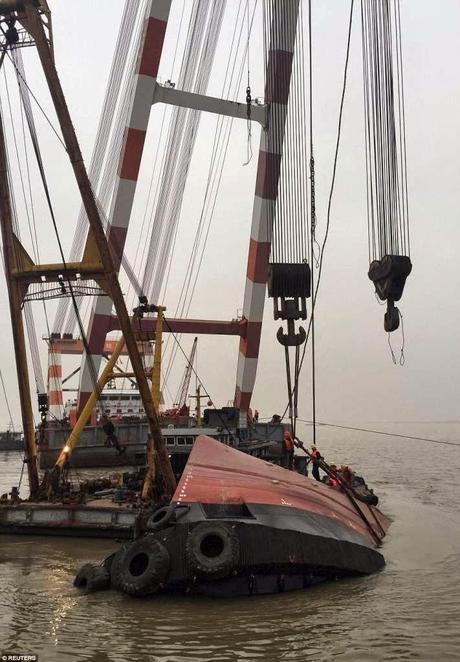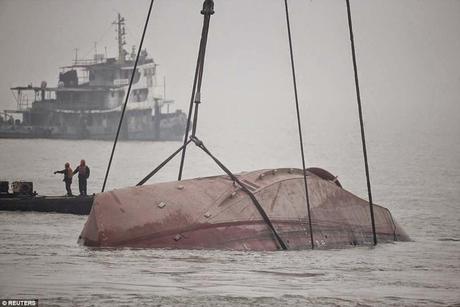 Rescuers, who had been
hampered by swift currents, finally managed to pull the 98-foot long
Wanshenzhou 67 into shallow waters later, allowing them to search inside. The
ship had been on a test voyage in the river's Fubei Channel, in Jiangsu
province, and it is understood the ship's owner, parts supplier and engineer
were among the 25 people aboard when it went under. The ship was built by Anhui Bengbu Shenzhou
Machinery Co. Ltd in October. Distraught relatives gathered at the banks of the
river, in Jiangsu province, to wait for news of their missing loved ones. A Singapore foreign ministry spokesman said Friday
that the vessel was registered in the city-state and four of its nationals were
on board.
Rescuers, who had been
hampered by swift currents, finally managed to pull the 98-foot long
Wanshenzhou 67 into shallow waters later, allowing them to search inside. The
ship had been on a test voyage in the river's Fubei Channel, in Jiangsu
province, and it is understood the ship's owner, parts supplier and engineer
were among the 25 people aboard when it went under. The ship was built by Anhui Bengbu Shenzhou
Machinery Co. Ltd in October. Distraught relatives gathered at the banks of the
river, in Jiangsu province, to wait for news of their missing loved ones. A Singapore foreign ministry spokesman said Friday
that the vessel was registered in the city-state and four of its nationals were
on board.
 The accident occurred on a
stretch of the river that experiences extremely strong currents, between the
cities of Jingjiang and Zhangjiagang, which is close to the Yangtze's mouth
near the commercial hub Shanghai. The provincial government said the boat was
undergoing trials without properly completing the required procedures and
without first reporting the condition of the ship, as required by regulations.
So like the ill-fated
Titanic, the newly built, 30-meter (98-foot) long Wanshenzhou 67 also sank on
(this time on its test voyage itself) taking along its owner, parts suppliers
and engineers.
As could be read, at some
places it is referred as a ship and as ‘tug’ in others. Tug boats look
similar to fishing trawlers but pack great power. These Tug boats are often smaller with
width:length ratio higher as it would need a lower draft. They require minimum crew – they are stationed
at harbours; pilot, pull and bring bigger ships in to their designated place
inside the Port. In ports where mid-sea
loading / unloading takes place, tugs would pull barges in a row. If it was indeed a tug, perhaps, it might not
have had this much crew !
This casualty occurred at ‘Yangtze’
– there is another river ‘Huang He’ often referred
as ‘yellow river’ originating in the Bayan Har Mountains in Qinghai
province of western China. It is called "the cradle of Chinese
civilization", because its basin was the birthplace of ancient Chinese
civilization, and it was the most prosperous region in early Chinese history.
However, frequent devastating floods and course changes produced by the
continual elevation of the river bed (due in part to manmade erosion upstream),
sometimes above the level of its surrounding farm fields, has also earned it the unenviable names ‘China's Sorrow’ and
Scourge of the Sons of Han.
With regards – S.
Sampathkumar
The accident occurred on a
stretch of the river that experiences extremely strong currents, between the
cities of Jingjiang and Zhangjiagang, which is close to the Yangtze's mouth
near the commercial hub Shanghai. The provincial government said the boat was
undergoing trials without properly completing the required procedures and
without first reporting the condition of the ship, as required by regulations.
So like the ill-fated
Titanic, the newly built, 30-meter (98-foot) long Wanshenzhou 67 also sank on
(this time on its test voyage itself) taking along its owner, parts suppliers
and engineers.
As could be read, at some
places it is referred as a ship and as ‘tug’ in others. Tug boats look
similar to fishing trawlers but pack great power. These Tug boats are often smaller with
width:length ratio higher as it would need a lower draft. They require minimum crew – they are stationed
at harbours; pilot, pull and bring bigger ships in to their designated place
inside the Port. In ports where mid-sea
loading / unloading takes place, tugs would pull barges in a row. If it was indeed a tug, perhaps, it might not
have had this much crew !
This casualty occurred at ‘Yangtze’
– there is another river ‘Huang He’ often referred
as ‘yellow river’ originating in the Bayan Har Mountains in Qinghai
province of western China. It is called "the cradle of Chinese
civilization", because its basin was the birthplace of ancient Chinese
civilization, and it was the most prosperous region in early Chinese history.
However, frequent devastating floods and course changes produced by the
continual elevation of the river bed (due in part to manmade erosion upstream),
sometimes above the level of its surrounding farm fields, has also earned it the unenviable names ‘China's Sorrow’ and
Scourge of the Sons of Han.
With regards – S.
Sampathkumar
20th Jan 2015.

